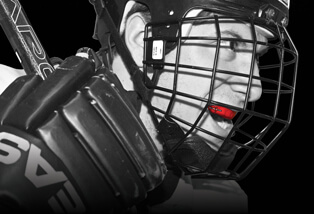Athletes: Are You Getting The Most Out Of Your Mouthguard?

 While it may be just one small part of your uniform, your mouthguard is a very important piece of athletic gear. From protection to performance, your mouthguard plays a valuable role on the field, court or ice.
While it may be just one small part of your uniform, your mouthguard is a very important piece of athletic gear. From protection to performance, your mouthguard plays a valuable role on the field, court or ice.
Are you getting the most out of your mouthguard? Find out how with these four tips:
1. Properly Protected
What’s the number one reason to wear your mouthguard? For protection, obviously!
If you’re struck in the face or mouth while playing sports, it’s going to be painful; and without the proper protection, pain is going to be just the first — yet not the worse — result. So how do you know that you’re getting the right amount of protection?
Proper protection starts with a minimum of 4 mm of material in the important impact zones, the areas in the front of the teeth and under the molars. However, these zones change from sport to sport; as a mouthguard that’s recommended for football may not be ideal for field hockey.
The amount of protection you need and where will vary by sport and age, so make sure you know exactly what you need. And make sure the mouthguard is custom-made.
When a mouthguard doesn’t fit correctly, there is no guarantee the mouthguard is going to be in place when impact comes. Custom mouthguards, however, are always in the right place at the right time. That’s why the American Dental Association and the Academy for Sports Dentistry say that custom mouthguards are 1000% more protective than any other kind of mouthguard.
2. Complaint-free Comfort
One of the biggest complaints athletes have about mouthguards is that they are uncomfortable, making it difficult to breathe and speak.
That’s because most mouthguards have unnecessary material in the free flow space — the areas behind the back of your upper front teeth, on the inside of your upper molars and on the roof of your mouth. This is where thick, protective material is unnecessary and impedes breathing and speaking.
Press your thumb to the back of your upper front teeth and try to speak. As you’ll notice, your speech turns into a muffled lisp. You need a mouthguard that keeps this area clear or has as little material as possible to allow clearer speech and breathing. That makes a mouthguard significantly more comfortable and much easier to wear.
Thankfully, mouthguards are now thinner and lighter than ever before. Comfort is key, and the right mouthguard provides a more intimate fit, allowing you to breathe, communicate and drink comfortably without removing your mouthguard.
3. Preferred Performance
As mouthguards continue to advance, the materials they are composed of continue to change as well. Gone are the days of boiling-and-biting a big chunk of rubber as mouthguards are now produced using state-of-the-art materials.
That means you’re getting higher performance mouthguards and guards that are much more durable, which is important, especially if you chew on your mouthguard. Material that is denser, not thicker, allows for better chewing resistance without sacrificing comfort. It also means your guard lasts much longer.
And mouthguards now feature performance upgrades, like technology that locks the lower jaw in a slightly forward position, giving the athlete 17% gains in extremity strength with less stress on the temporomandibular joint. According to Kinesiology studies, this helps make the athlete’s body more relaxed for greater range of motion, flexibility and balance — meaning athletic performance is actually enhanced by a mouthguard.
4. Standout Style
While protection, comfort and performance are all important, let’s not forget — your mouthguard is a part of your uniform. Make it stand out!
With complete personalization — from color and logo to name and number — you don’t just get a piece of equipment, but a new favorite piece of team gear and an essential component to complete your game face.
From protection to performance, your mouthguard plays a valuable role on the field, court or ice. Are you getting the most out of your mouthguard?






